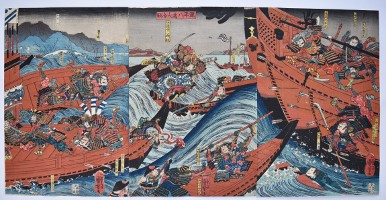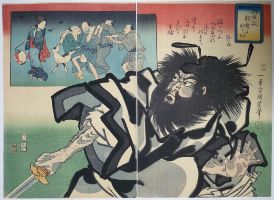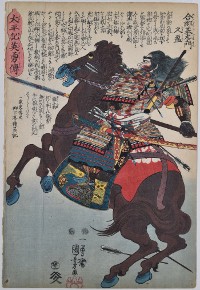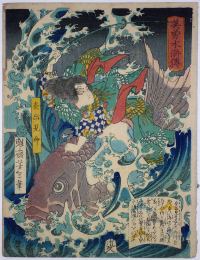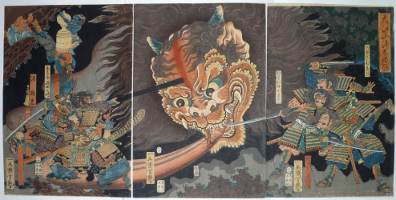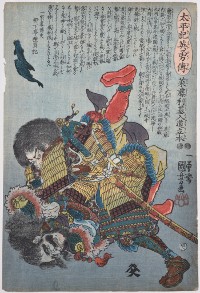/category/warriors-and-legends/page/2/
Tsukioka YOSHITOSHI (1839-1892)

Click here to view image full size.
A triptych from a set of ten: Dai Nippon shiryaku zue, “Short Illustrated History of Great Japan.” Each print is in the form of an unrolled makimono. This design shows the third son of the twelfth century Emperor Keiko, Yamato Takeru no mikoto (Wo-usu). His father was constantly sending him on dangerous missions making him suspect that he wished his death. One such journey was to the Emishi in northeast Japan. On complaining about this to his high-priestess aunt, Yamatohime, she gave him the famous sword Ame no murakumo no hoken to aid him. On his arrival, the ruler of the Emishi lured him onto open grassland which he set on fire. Wo-usu used his sword to cut the grass, evade death, and start new fires to kill his enemy. Published by Kobayashi, 1880. A fine design.
Fine impression of first edition. Fine colour. Very slight crease bottom margin of centre sheet, otherwise fine condition. Signed Taiso Yoshitoshi.
Status: Available
Tamagawa SHUNSUI (Active 1772-1781)

Click here to view image full size.
A hashira-e, “pillar print” by a rare artist, a pupil of Choshun who went on to teach Katsukawa Shunsho. Produced a few chuban, hosoban, and pillar prints. Shows the Minamoto (Genji) warrior Kumagai Naozane ,above, attacking the Taira (Heike) warrior Taira no Atsumori, below, at the battle of Ichi-no-Tani in 1184 during the Genpei war. Pillar prints were introduced to hang, when mounted, on the pillars of a Japanese house. Consequently, they often come browned, creased or faded and finding good examples is difficult. Rare: Another impression is in MFA, Boston, acc. no. 28.500.
Very good impression and colour. Light toning but otherwise very good condition. Signed Tamagawa Shunsui ga.
Status: Available
Utagawa KUNIYOSHI (1797-1861)

Click here to view image full size.
A rare early Kuniyoshi triptych, Minamoto no Yorimitsu no Shitenno tsuchigumo taiji no dzu, showing Minamoto no Yorimitsu (Raiko) and his loyal retainers: Watanabe no Tsuna, Usui no Sadamitsu, Sakata no Kintoki and Urabe no Suetake killing the giant “Earth Spider.” Numerous versions exist of this story but basically Raiko and his followers have to tackle various horrendous apparitions in a cave within the hill Kagura ga oka near Kyoto, eventually to be faced by a beautiful woman who envelops Raiko in cobwebs. He slays her and her body turns into a spider, the head being twenty-five feet long and eyes shining like the sun and moon. He cuts off the beast’s head and the carcase reveals the many bodies devoured by it. Published by Maru-ya Seijiro, c 1838. Robinson T46 and illustrated in colour, Kuniyoshi, B.W.Robinson, Phaidon 1982, plate 37.
Very good impression and colour. Minor creasing, otherwise very good condition. Signed Ichiyusai Kuniyoshi ga.Very good impression. Slight fading, otherwise good colour. Very good condition. Signed Ichiyusai Kuniyoshi ga.
Status: Available
Utagawa KUNIYOSHI (1797-1861)

Click here to view image full size.
The general Morozumi Masakiyo, Lord of Bungo and a retainer of the Takeda Clan (Shingen of Kai Province) in a battle with the Uesugi Clan (Kenshin of Echigo Province), The wars taking place between 1553 and 1563. From a set Koetsu yusho den, “Stories of Courageous Generals of the Provinces of Echigo and Kai.” Masakiyo is shown committing suicide by inserting his sword into his mouth while being blown up by a land-mine. As with so much in Japan, the land-mine originated in China from early times. Published by Sumiyoshiya Masagoro, c 1848-9. One of the “three great deaths” of these wars.
Very good impression with extensive sprayed pigment around the exploding mine. Slight fading, otherwise very good condition. Signed Ichiyusai Kuniyoshi ga.
Status: Available
Taiso YOSHITOSHI (1839 – 1892)

Click here to view image full size.
Watanabe no Tsuna on horseback in the rain. One of the finest designs from Wakan hyaku monogatari. Published by Daikin, 1865/2.
Fine impression and colour. Minor wormage otherwise very good condition. Signed Ikkaisai Yoshitoshi ga.
Status: Available
Utagawa KUNIYOSHI (1797-1861)
Click here to view image full size.
Gempei Yashima o-kassen, the great battle of Yashima in 1184. Shows Yoshitsune’s famous “eight-boat leap” (centre), Noritsune (left), and Benkei on the large boat (right). Published by Kawaguchiya Uhei, c. 1839-41.
Very good impression and colour. Edge repair top left sheet, otherwise very good condition. Signed Ichiyusai Kuniyoshi ga.
Status: Available
Taiso YOSHITOSHI (1839-1892)
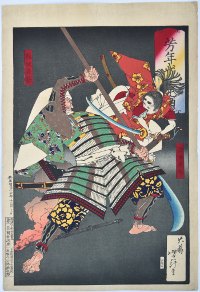
Click here to view image full size.
Minamoto no Ushiwakamura battling with Kumasaka Chohan. From the fine set Yoshitoshi mushaburui, “Yoshitoshi’s Courageous Warriors.” Published by Kobayashi, 1883-1886 (this being 1883).
Fine impression and colour. Light toning, otherwise fine condition. This is the first edition. There are a number of later states and the set was republished by Tsunajima in 1886.
Status: Sold
Utagawa KUNIYOSHI (1797-1861)
Click here to view image full size.
A triptych Akazawa-yama o-sumo showing the most famous sumo match in Japanese history between Kawazu Saburo Sukeyasu and Matano Goro Kagehisa at Akazawa mountain. Also famous as Kawazu used a new sumo hold wrapping a foot around his opponent’s leg and encircling the neck with one arm, a manoeuvre that became known as the Kawazu hold. The event took place in 1176 before Shogun Minamoto Yoritomo where Kawazu defeats the popular bully Matano. Subsequently Kawazu was murdered, quite unrelated to the bout. His sons swear revenge and their story becomes the Soga monogatari. Kawazu is shown here throwing Matano to the ground, the referee to the left. Published 1858 by Maruya Kyushiro. Robinson T353. Provenance: Purchased from me in 1994.
Superb impression and colour. One small thinned area, otherwise very fine condition. Probably the finest impression extant of this famous design. Signed Kuniyoshi ga and Ichiyusai Kuniyoshi ga.
Status: Sold
Utagawa KUNIYOSHI (1797-1861)
Click here to view image full size.
An extremely rare diptych, Shoki-san jaki ni sokko, “Shoki-San, Quick-Acting Medicine to Remove Evil Spirits.” Images of Shoki were used to ward off evil spirits and illness, especially during the Boys’ Festival. Published 1858 by Enshuya Hikobei. Provenance: Purchased from me in 1994.
Extremely fine impression. Fine colour and condition. Signed Ichiyusai Kuniyoshi fude with Yutaka seal.
Status: Sold
Utagawa KUNIYOSHI (1797-1861)
Click here to view image full size.
Kwaido Maru (Kintoki) seizes Raijin, the Thunder God, with one hand while holding his thunder drums with the other. A thunderbolt falls to earth causing flashes of lightning. A fine and rare set: Honcho musha kagami, “Mirror of Warriors of our Country.” The set published by Tsujioka-ya Bunsuke, 1855. Robinson S87.6.
Fine impression. Slightly trimmed, otherwise very good condition. Signed Ichiyusai Kuniyoshi ga.
Status: Sold
Utagawa KUNIYOSHI (1797-1861)
Click here to view image full size.
A triptych showing the famous archer Minamoto no Yorimasa preparing to shoot the monster Nue on the roof of the Shishinden Palace. The story relates how in 1153 the sixteen year old Emperor Konoe was having difficulty sleeping due to the shrieks and scratchings emanating from the palace roof. Guards informed him that a black cloud descended there every night. Yorimasa was called upon to investigate and he brought down the beast – a composite creature, part monkey, badger, tiger, dragon and snake which was duly despatched by his retainer Hironao no Hayata (Tadazumi no Hayata). Subsequently Konoe sleeps soundly and rewards Yorimasa with a fine sword and a court beauty Yorimasa loves. An exceptional design published 1842-3 by Yamashiroya Shinroku. Robinson T112. Provenance: Purchased from me in 1994.
Fine impression, colour and condition. Signed Ichiyusai Kuniyoshi ga.
Status: Sold
Utagawa KUNIYOSHI (1797-1861)
Click here to view image full size.
Hironao no Hayata (Tadazumi no Hayata), Yorimasa’s retainer (see the triptych by Kuniyoshi of the same subject on this update), grappling with the composite beast Nue on the roof of the Shishinden Palace. Forked lightning bounces around him. One of the best designs from Honcho Suikoden goyu happyaku-nin no hitori, “Eight Hundred Heroes of our Country’s Suikoden, One by One.” Published by Kagaya Kichiemon, 1830-31.
Very good impression and colour. Slight trimming, otherwise very good condition. Signed Ichiyusai Kuniyoshi ga.
Status: Sold
Utagawa KUNIYOSHI (1797-1861)
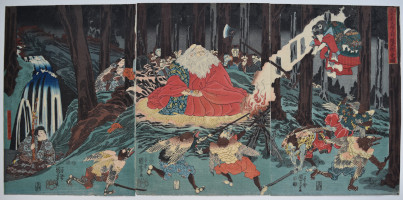
Click here to view image full size.
A triptych showing Ushiwaka Maru (Minamoto no Yoshitsune’s childhood name), attended by Kisanda, practising fencing with the karasu or “crow” tengu in a forest glade on Mt. Kurama, north of Kyoto. His training in martial arts is being supervised by a white-bearded yamabushi tengu, Sojobo, King of the Tengu. (The yamabushi were followers of Shugendo– a shamanistic mountain ascetism.) Yoshitsune (1159-1189) is the best known Japanese warrior and a popular subject for Japanese artists and craftsmen. Famous for exploits such as the battle on Gojo Bridge with Benkei and the battle of Dan-no-ura. Published by Enshuya Hikobei, 1851-2. Robinson T264.
Fine impression. This is the first state with gradation on the rocks top left. Fine colour. Very good condition. Signed Ichiyusai Kuniyoshi ga.
Status: Sold
Utagawa YOSHIKATA (Fl. 1841-1864)

Click here to view image full size.
A triptych showing the second battle of Uji River on February 19th, 1184. The centre sheet shows Taira Minamoto Yoshitsune and Benkei with their horses leading the troops to defeat Minamoto no Yoshinaka. The bridge had been dismantled so the small army had to ford the river which was in spate, because of early snow melt, against volleys of arrows and abatis barriers in the river bed (a method of cutting trees down, sharpening their ends and staking them into the river bed facing the enemy). Published by Iseya Tokichi, 1863.
Fine impression, colour and condition. Signed Isshinsai Yoshikata ga.
Status: Sold
Tsukioka YOSHITOSHI (1839-1892)

Click here to view image full size.
A bloodied Sugenoya Kuemon resting his head on the hilt of his sword in stormy weather from a set Kaidai hyaku, “Yoshitoshi’s Selection of One Hundred Warriors.” Sixty-five prints published by Ohashiya Yashichi between 1868 and 1869, this being 1868. The text in the square cartouches in this set refer to prominent warriors in the internecine wars of the 16th century but in fact the subjects are Shogitai soldiers. (Those that held out against the imperial forces and were massacred at Ueno, 4/7/1868.) Possibly the best design from this fine set.
Fine impression of the early state with dark background and yellow at the bottom of the title cartouche. Fine colour and condition. Signed Ikkaisai Yoshitoshi htsu.
Status: Sold
Kobayashi KIYOCHIKA (1847-1915)

Click here to view image full size.
Taira no Tadamori Mido hoshi o toraen zu. The story relates how the Emperor Shirakawa was perturbed by a monster in the precincts of the Mido Temple at night. He commands the samurai Taira no Tadamori to kill it. The triptych shows Tadamori discovering that the monster is, in fact, the bedraggled old priest of Mido Temple who steals oil from the stone lanterns. Published by Hara Taneaki, c 1883.
Very fine impression with particularly fine gradation and printing. Fine colour. Minor edge damage, otherwise fine condition. Full margins: This design often comes with the title and or publisher’s seal trimmed. Signed Hoensha Kiyochika hitsu.
Status: Sold
Utagawa KUNIYOSHI (1797-1861)
Click here to view image full size.
Aigo Gozayemon Hisamitsu (Haigo Gozaemon Hisamitsu) mounted and armoured (less helmet) in battle levelling his long spear. He was a retainer of the Oda family and served under Shibata Katsuiye. From the set Taiheiki yeiyuden, “Heroic Stories of the Taiheiki. A history of the wars of the loyalist Nitta and Kusunoki families against the Ashikaga war-lords during the second quarter of the fourteenth century. But in fact the subject of this set of fifty prints (this design numbered 43) is the civil war of the late 16th century. Censorship restrictions imposed in the 1840s prevented publishers from illustrating historical subjects from the Tensho era 1573-92 onwards, so the publishers circumvented this by slightly altering the names of the historical figures. Published 1848-9 by Yamamoto-ya Heikichi. Robinson S62.1. One of the best designs from the set.
Very fine impression. Fine colour and condition. Signed Ichiyusai Kuniyoshi ga.
Status: Sold
Utagawa KUNIYOSHI (1797-1861)
Click here to view image full size.
Negoro- no Komizucha (Negoro-no Komizucha) dressed as a warrior-monk fighting with a long nail-studded club (a tetsubo) and a broken naginata. Swords and arrows fly about him.. From the set Taiheiki yeiyuden, “Heroic Stories of the Taiheiki. A history of the wars of the loyalist Nitta and Kusunoki families against the Ashikaga war-lords during the second quarter of the fourteenth century. But in fact the subject of this set of fifty prints (this design numbered 26) is the civil war of the late 16th century. Censorship restrictions imposed in the 1840s prevented publishers from illustrating historical subjects from the Tensho era 1573-92 onwards, so the publishers circumvented this by slightly altering the names of the historical figures. Published 1848-9 by Yamamoto-ya Heikichi. Robinson S62.26. One of the best designs from the set.
Fine impression and colour. Very good condition. Signed Ichiyusai Kuniyoshi ga.
Status: Sold
Kobayashi KIYOCHIKA (1847-1915)
Click here to view image full size.
Shows Captain Kani Ichita who, because he was suffering from dysentery, broke down 100 yards from the assault on Two Dragon Hill at the siege of Port Arthur in the Russo-Japanese war ( 1/8/1904-2/1/1905 ). Not able to forgive his weakness, he went back to the same spot a week later and commited seppuku. From a set Rikukaigunjin komei kagami, “Mirror of Army and Navy Heroes.” Published by Inoue Kichijiro, 2/1895. For whatever reason, a rare set. Fine design.
Fine impression and colour. Signs of mounting au verso, otherwise fine condition. Signed Kiyochika.
Status: Sold
Utagawa KUNIYOSHI (1797-1861)
Click here to view image full size.
Fukishima Masamori (Fukushima Masanori) in armour struggling with three assailants. He was the son of a cooper in the province of Owari. From the set Taiheiki yeiyuden, “Heroic Stories of the Taiheiki. A history of the wars of the loyalist Nitta and Kusunoki families against the Ashikaga war-lords during the second quarter of the fourteenth century. But in fact the subject of this set of fifty prints (this design numbered 15) is the civil war of the late 16th century. Censorship restrictions imposed in the 1840s prevented publishers from illustrating historical subjects from the Tensho era 1573-92 onwards, so the publishers circumvented this by slightly altering the names of the historical figures. Published 1848-9 by Yamamoto-ya Heikichi. Robinson S62.9. One of the best designs from the set.
Fine impression and colour. Small binding holes, otherwise very good condition. Signed Ichiyusai Kuniyoshi ga.Published 1848-9 by Yamamoto-ya Heikichi. Robinson S62.2. One of the best designs from the set.
Status: Sold
Kobayashi KIYOCHIKA (1847-1915)
Click here to view image full size.
Lieutenant Mitsutani on horseback in swirling smoke. From a set Rikukaigunjin komei kagami, “Mirror of Army and Navy Heroes.” Published by Inoue Kichijiro 1895. I have been unable to get any information on this hero. For whatever reason, a rare set. Fine design.
Fine impression and colour. Signs of mounting au verso, otherwise fine condition. Signed Kiyochika.
Status: Sold
Utagawa KUNIYOSHI (1797-1861)
Click here to view image full size.
Akashi Ridayu Hidemoto (Akashi Gidayu Tadamasu) with a peasants’ straw raincoat over his armour and armed with a hoe. On one occasion, together with Shioren Sajima, he commanded a force of men dressed as farmerts. From the set Taiheiki yeiyuden, “Heroic Stories of the Taiheiki. A history of the wars of the loyalist Nitta and Kusunoki families against the Ashikaga war-lords during the second quarter of the fourteenth century. But in fact the subject of this set of fifty prints (this design numbered 34) is the civil war of the late 16th century. Censorship restrictions imposed in the 1840s prevented publishers from illustrating historical subjects from the Tensho era 1573-92 onwards, so the publishers circumvented this by slightly altering the names of the historical figures. Published 1848-9 by Yamamoto-ya Heikichi. Robinson S62.2. One of the best designs from the set.
Very fine impression, colour, and condition. Signed Ichiyusai Kuniyoshi ga.
Status: Sold
Tsukioka YOSHITOSHI (1839-1892)
Click here to view image full size.
The demon Ibaraki of Rashomon ( a gate south of the Imperial Palace in Kyoto ) visits Watanabe no Tsuna disguised as an old woman to retrieve its severed arm. This famous story relates how Watanabe cut off the arm after camping out at the gate to rid the neighbourhood of the beast. ( See below on this website for Yoshitoshi’s vertical diptych of the same subject. ) From Yoshitoshi manga, “Sketches by Yoshitoshi” from a fine set of seven diptychs. Published by Kobayashi 1885-86 ( this being 1885 ).
Very fine impression of the first edition. Fine colour. Fine condition apart from one minor mark. As originally published with no backing paper, with the margins completely untrimmed ( often cut in this set ), and plenty of space for joining. Signed Yoshitoshi ga.
Status: Sold
Tsukioka YOSHITOSHI (1839-1892)
Click here to view image full size.
The best design from the set Tsuki hyakushi, the “Hundred Phases of the Moon”. The set published between 1885 and 1892 ( this being 1886 ) by Akiyama Buemon. Benkei against a full moon. In 1185 Yoshitsune attacked by his half-brother Minamoto no Yoritomo, was forced to flee to northern Japan by ship. Sailing along the Inland Sea off the coast of Harima Province not far from Kyoto, the ship was struck by a storm in Daimotsu Bay caused by the vengeful ghosts of the Taira warriors Yoshitsune and his men had slain. Benkei pacified the spirits in the prow of the boat by holding up his string of prayer beads.
Fine impression, colour and condition. (A good guide to the quality of the impression is to look at the outline of Benkei’s face: This fine line started to break down early on.) An impression that has not been in an album: Full margins with very extensive mica. Signed Yoshitoshi.
Status: Sold
Tsukioka YOSHITOSHI (1839-1892)
Click here to view image full size.
Roba kiwan o mochisaru zu, the best design from Shinkei sanjurokkaisen, “New Forms of Thirty-Six Ghosts.” The set published by Sasaki Toyokichi, 1889. The well-known story relates how Watanabe no Tsuna cuts off the arm of the demon Ibaraki near the Rashomon Gate in Kyoto in 976. Watanabe locks the arm in a box. Subsequently he is visited by his wet-nurse who asks to see the arm, whereupon she seizes it and flies off revealing her true guise as that of the demon. The story was made into a no play, Ibaraki, and later a kabuki play.
Very fine first edition, fine colour and condition. Full size with the publishing details intact on left margin. The second edition (with only two-colour cartouche) is shown on the front cover of The Age of Yoshitoshi, The Rijksmuseum, 1990 and no. 47, p. 40. Signed Yoshitoshi.
Status: Sold
Tsukioka YOSHITOSHI (1839-1892)
Click here to view image full size.
Hohodemi Mikoto battling a giant bream to regain the magic fish hook. The best design from a fine chuban set Biyu Suikoden published by Omiya Kyujiro, 1866/7 (this being 1867). He eventually marries the Sea God’s daughter Princess Toyotama. There is a later edition with the publisher’s name removed.
Very good impression, colour and condition. Signed Kaisai Yoshitoshi hitsu.
Status: Sold
Tsukioka YOSHITOSHI (1839-1892)
Click here to view image full size.
Takagi Umanosuke, a seven foot tall Jujutsu master, holding a trial of courage with a giant ghost in an ancient temple. He also mastered the arts of Bojutsu (staff), Sojutsu (spear), and Naginarajutsu (halberd). One of the best designs from a fine chuban set Biyu Suikoden published by Omiya Kyujiro, 1866/7 (this being 1866). There is a later edition with the publisher’s name removed.
Very good impression and colour.One small mark, otherwise good condition. Signed Kaisai Yoshitoshi hitsu.
Status: Sold
Utagawa KUNIYOSHI (1797-1861)
Click here to view image full size.
Inuzaka Keno Tanetomo struggling with four adversaries from Kyokutei-o seicho Hakkenshi zui-ichi, “The One and Only Eight Dog History of Old Kyokutei [Bakin], Best of Refined Authors.” The set of eight prints form diptychs and are based on Bakin’s (1767-1848) famous novel Satomi Hakkenden, “Eight Dogs of the Satomi Clan.” Robinson S5.7.
Very good impression, colour and condition. Signed Ichiyusai Kuniyoshi ga.
Status: Sold
Tsukioka YOSHITOSHI (1839-1892)
Click here to view image full size.
Fushimi ojishin Momoyama goten no zu. Shows Kato Kiyomasa protecting Toyotomi Hideyoshi during the earthquake which destroyed the Fushimi castle two years after it was completed in 1594. Published by Fukase, 1885.
Very fine impression, colour and condition with extra paper around. Signed Oju Taiso Yoshitoshi ga.
Status: Sold
Ichieisai YOSHITSUYA (1822-1866)
Click here to view image full size.
Raiko and his four retainers: from left to right, Sakata no Kintoki, Usui no Sadamitsu, Watanabe no Tsuna and Urabe no Suyetake on Oyeyama, “Devil’s Mountain.” Shows Raiko having just decapitated the giant head of the demon Shuten-doji which then descended upon his helmet. Unidentified publisher, 1858.
Fine impression. Very good colour and condition. Signed Ichieisai Yoshitsuya ga
Status: Sold
Tsukioka YOSHITOSHI (1839-1892)
Click here to view image full size.
Daininbo Umegae o satsugai no zu, “Picture of the Priest Dainin Killing the Girl Umegae from the set Shinsen azuma nishiki-e, “New Selection of Eastern Brocade Pictures.” The set was based on episodes from kabuki drama although set in naturalistic surroundings. Published by Tsunashima Kamekichi between 1885-89 (this being 1886).
Very fine impression, colour and condition. Full, untrimmed yellow borders. Two-colour cartouche: Supposedly the first edition has three-colour cartouche but this impression could not be better, so presumably the printer had a forgetful day. Signed Yoshitoshi.
Status: Sold
Utagawa KUNIYOSHI (1797-1861)
Click here to view image full size.
Ina-uye Daikuro Masatada (Inoue Daikuro Nagayoshi) in armour but without helmet, his sashimono adorned with a skull, about to discharge a huge gun. From the set Taiheiki yeiyuden, “Heroic Stories of the Taiheiki. A history of the wars of the loyalist Nitta and Kusunoki families against the Ashikaga war-lords during the second quarter of the fourteenth century. But in fact the subject of this set of fifty prints (this design numberSurimono 033ed 47) is the civil war of the late 16th century. Censorship restrictions imposed in the 1840s prevented publishers from illustrating historical subjects from the Tensho era 1573-92 onwards, so the publishers circumvented this by slightly altering the names of the historical figures. Published 1848-9 by Yamamoto-ya Heikichi. Robinson S62.16. One of the best designs from the set.
Fine impression, colour, and condition. Signed Ichiyusai Kuniyoshi ga.
Status: Sold
Utagawa KUNIYOSHI (1797-1861)
Click here to view image full size.
Kido Takuzayemon Nagachika (Kido Sakuzaemon Norishige) on stone steps above a river attempting to prise open a metal grill. He was lord of the castle of Uda in Higo Province. From the set Taiheiki yeiyuden, “Heroic Stories of the Taiheiki. A history of the wars of the loyalist Nitta and Kusunoki families against the Ashikaga war-lords during the second quarter of the fourteenth century. But in fact the subject of this set of fifty prints (this design not numbered) is the civil war of the late 16th century. Censorship restrictions imposed in the 1840s prevented publishers from illustrating historical subjects from the Tensho era 1573-92 onwards, so the publishers circumvented this by slightly altering the names of the historical figures. Published 1848-9 by Yamamoto-ya Heikichi. Robinson S62.19. One of the best designs from the set.
Fine impression and colour. Small binding holes, otherwise very good condition. Signed Ichiyusai Kuniyoshi ga.
Status: Sold
Utagawa KUNIYOSHI (1797-1861)
Click here to view image full size.
Orio Mosuke Yasuharu (Horio Mosuke Yoshiharu) in early youth overcoming a huge wild boar. A feat which caused Hideyoshi to take him into his service. From the set Taiheiki yeiyuden, “Heroic Stories of the Taiheiki. A history of the wars of the loyalist Nitta and Kusunoki families against the Ashikaga war-lords during the second quarter of the fourteenth century. But in fact the subject of this set of fifty prints (this design not numbered) is the civil war of the late 16th century. Censorship restrictions imposed in the 1840s prevented publishers from illustrating historical subjects from the Tensho era 1573-92 onwards, so the publishers circumvented this by slightly altering the names of the historical figures. Published 1848-9 by Yamamoto-ya Heikichi. Robinson S62.27. One of the best designs from the set.
Fine impression, colour, and condition. Signed Ichiyusai Kuniyoshi ga.
Status: Sold
Utagawa KUNIYOSHI (1797-1861)
Click here to view image full size.
Saito Toshimoto nyudo Ryuhon (Saito Toshimitsu nyudo Ryuhon) in armour struggling with a Chinese brigand underwater. From the set Taiheiki yeiyuden, “Heroic Stories of the Taiheiki. A history of the wars of the loyalist Nitta and Kusunoki families against the Ashikaga war-lords during the second quarter of the fourteenth century. But in fact the subject of this set of fifty prints (this numbered 48) is the civil war of the late 16th century. Censorship restrictions imposed in the 1840s prevented publishers from illustrating historical subjects from the Tensho era 1573-92 onwards, so the publishers circumvented this by slightly altering the names of the historical figures. Published 1848-9 by Yamamoto-ya Heikichi. Robinson S62.31. One of the best designs from the set.
Fine early impression. Fine colour. Slight nibbling to left edge, otherwise very good condition. Signed Ichiyusai Kuniyoshi ga.
Status: Sold
Tsukioka YOSHITOSHI (1839-1892)
Click here to view image full size.
The most gruesome of Yoshitoshi’s designs showing the old hag of the Lonely House about to eviscerate the pregnant woman hanging from the roof. Published by Matsui Eikichi, 1885.
Fine impression of the first edition. Little work has been done on the various states in this set other than that most were reprinted by Hasegawa Tsunejiro. Fine colour. Very full size with large margins left, top and where the sheets join. (The left border is often trimmed thereby losing the publication details.) Minor soil, otherwise fine condition. On thick hosho. Signed Oju Yoshitoshi.
Status: Sold
Utagawa KUNIYOSHI (1797-1861)
Click here to view image full size.
The stern of a large sailing-junk and a smaller vessel infront. A poem by Sangi Takamura (Ono no Takamura) from Hyaku-nin isshu, “The Hundred Poets” published by Ebine c 1838. Depending which story one reads, either Takamura, who was a customs official for ships trading to and from China, went missing on a mission or was reported for being an extortioner and banished to the Oki Islands. Either way, he was subsequently pardoned. One of the best designs from this fine set. Robinson S19.11 and illustrated in Robinson (1961), no. 59.
Fine impression, colour and condition. Signed Ichiyusai Kuniyoshi ga.
Status: Sold
Utagawa KUNIYOSHI (1797-1861)
Click here to view image full size.
A triptych showing the famous battle on Gojo Bridge between Ushiwaka Maru (Minamoto no Yoshitsune’s childhood name) and Benkei. Yoshitsune is aided by Sojobo, King of the Tengu (white-bearded in the centre), and other yamabushi tengu. Published by Enshuya Hikobei, 1847-50. Robinson T194.
Very fine impression and colour. Fine condition. This is the best example I have seen of this design. Signed Ichiyusai Kuniyoshi ga.
Status: Sold
Utagawa KUNIYOSHI (1797-1861)
Click here to view image full size.
The priest Nichiren standing on the rocky promontory at Reizan in Kamakura and having his prayers for rain answered. The event occurred in 1271. His disciples surround him and protect him from the deluge with a large umbrella. Bunei hachi Kamakura Reizan-ga-saki uki. The second best design from Koso [ Nichiren ] goichidai ryakuzu, “Illustrated Abridged Biography of the Founder.” Nichiren ( 1222 – 1282 ) was the founder of the Buddhist Nichiren sect ( Nichiren shu – Kuniyoshi being a follower ) and indeed the set of ten prints may have been commissioned to mark the 550th anniversary of his death. Published by Iseya Rihei c 1831.
Fine impression. This example has an orange-red colour used on Nichiren’s robe and umbrella, rather than the brighter red of other impressions. Also, the far mountains are more subtly rendered than on other examples.Very good colour and condition. Slight centre fold. Full size with ample room on top border for the umbrella which protrudes beyond the border and is notorious for being trimmed. Signed Ichiyusai Kuniyoshi ga.
Status: Sold
Utagawa KUNIYOSHI (1797-1861)
Click here to view image full size.
The priest Nichiren calming a storm at Kakuda on his way to Sado Island by invoking the name of the Lotus Sutra (namu myoho rengekyo) which is shown written on the waves. From Koso goichidai ryakuza, “Illustrated Abridged Biography of the Founder.” Nichiren was the founder of the Buddhist Nichiren sect (Nichiren shu – Kuniyoshi being a follower) and indeed the set of ten prints may have been commissioned to mark the 550th anniversary of his death. Published c 1831 by Iseya Rihei. One of the three best designs from the set.
Fine impression and colour. Slight centre fold, otherwise fine condition with splashed gofun. Full size. Signed Ichiyusai Kuniyoshi ga.
Status: Sold
